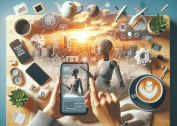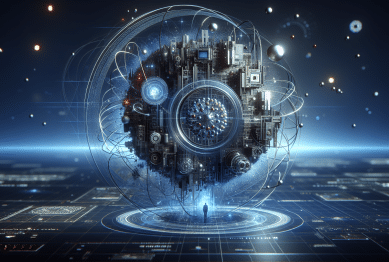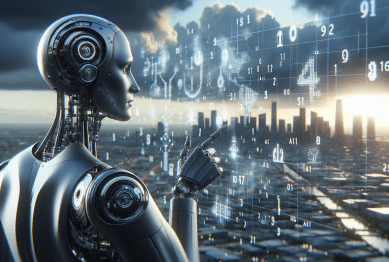Artificial intelligence is shaping daily experiences in ways both visible and invisible. This guide unpacks how AI-driven tools and algorithms work, why they’re influencing everything from smart assistants to healthcare, and what emerging advancements could mean for you.
Understanding Artificial Intelligence and Your World
Artificial intelligence (AI) describes computer systems that mimic human abilities such as learning, reasoning, and problem-solving. Rather than relying on hand-coded rules, these systems use data to adapt and improve over time. What once sounded like science fiction is now integrated into everyday devices. Smartphones rely on AI-powered voice assistants, while streaming platforms suggest content using machine learning. For many, these tools feel intuitive and seamless, although the technology underneath is complex. The spread of AI is transforming work, communication, and leisure in profound ways.
Every interaction with search engines, social media, or digital assistants leaves a trail of data. This information is absorbed by AI algorithms, enabling smarter services. For example, natural language processing helps devices understand and respond to spoken commands. Meanwhile, facial recognition unlocks phones and secures sensitive data, demonstrating how AI enables convenience and security. Some individuals may not realize the reach of artificial intelligence, but its influence is expanding rapidly across transportation, customer service, and healthcare fields.
AI isn’t just about efficiency — it’s also about personalization. Recommendation systems learn a user’s preferences, presenting tailored suggestions on platforms like YouTube or Amazon. This ability to analyze patterns has reshaped shopping habits and entertainment choices. In finance, AI processes vast amounts of information to detect fraud and automate transactions, creating a safer environment for users. As digital tools become even more integrated with personal habits, understanding how AI operates can foster trust and empower smarter choices.
The Power of Machine Learning Behind Everyday Tools
Machine learning is a subset of AI that enables computers to learn from data and make predictions or decisions without explicit programming. In daily life, this means email services can filter out spam, cameras recognize faces in photos, and music apps generate playlists based on listening habits. The more data these systems receive, the more accurate and useful they become. For instance, email spam filters are trained on millions of examples to distinguish junk mail from valuable messages. Over time, they adapt to new tricks used by spammers, making the user experience smoother.
Healthcare has seen a surge of machine learning technologies, from detecting diseases in medical images to identifying patterns in patient data that alert doctors to potential issues. AI supports radiologists in accurately interpreting scans, which improves diagnosis and can potentially save lives. Similarly, wearable fitness devices analyze movement and heart rate, alerting individuals to abnormal activity. The role of AI in monitoring vital signs is expanding, bringing health insights to the wrist.
Financial services leverage machine learning for credit scoring, fraud detection, and even customer interaction. When someone applies for a loan, algorithms process complex variables far faster than humans. Banks can flag unusual account activity, decreasing the risk of identity theft. Machine learning also powers robo-advisors that offer investment guidance, making financial planning more accessible. These practical uses highlight how AI both automates complex decisions and customizes solutions for individual needs.
Smart Devices, Smart Living: AI in the Home
Homes are evolving into smart spaces, powered by AI-driven devices and sensors. Voice-activated assistants like Google Home or Amazon Alexa allow users to control lights, thermostats, and security cameras with simple spoken commands. These assistants use natural language processing to translate requests into actions. The core technology enables routines — for instance, adjusting lighting based on time of day or playing music suited to a morning workout. As AI improves, it will become increasingly predictive, anticipating individual routines.
Appliances are also getting smarter. AI-enabled refrigerators track inventory, suggest recipes, and even alert when food is about to expire. Robotic vacuum cleaners navigate rooms with mapping algorithms, optimizing cleaning paths without user intervention. Security systems now use motion sensors and facial recognition to distinguish between family, guests, and potential trespassers. Homeowners can remotely monitor and manage these systems, often from their smartphones, instilling convenience and peace of mind.
Energy conservation is another benefit of smart home AI. Intelligent thermostats learn occupant habits to adjust temperatures efficiently, reducing utility bills and environmental impact. Lighting systems adapt brightness based on natural light or occupancy. These automated processes, guided by machine learning, aim to optimize comfort and sustainability. For those interested in accessible smart living, advances in AI are making high-tech home environments more attainable and easier to manage.
Ethical Considerations and Bias in Intelligent Algorithms
While AI brings convenience, it also raises ethical questions. Algorithms trained on biased data can amplify social inequalities. For example, facial recognition systems have been criticized for misidentifying certain demographics, prompting debate about the fairness and transparency of AI applications. Many experts stress the importance of diverse datasets and regular audits to catch unintended consequences. These challenges have motivated growing calls for accountability in the development and deployment of intelligent systems.
Transparency is essential. Some organizations now advocate for ‘explainable AI,’ where users and regulators can understand decisions made by algorithms. This is particularly important in high-stakes environments such as criminal justice or hiring, where algorithmic bias can have serious implications. Ethical AI design is becoming a core focus among leading tech companies and institutions, with many adopting guiding principles that prioritize fairness and privacy.
Policymakers and researchers continue to develop frameworks for responsible AI. Balancing innovation with safeguards requires careful collaboration between governments, industry, and civil society. The aim is to create standards that ensure AI systems are beneficial, inclusive, and respectful of human rights. Taking part in these conversations, individuals can influence the trajectory of intelligent technologies and help shape a more equitable digital future.
AI in Science: Breakthroughs and Limitless Possibilities
Artificial intelligence is accelerating scientific discovery across disciplines. In drug development, AI models predict molecule interactions, shortening research timelines and increasing accuracy. Climate scientists use AI-powered simulations to forecast changes, helping to develop better solutions for global challenges. In astronomy, machine learning detects exoplanets and maps cosmic phenomena, handling amounts of data too vast for human analysis. These advancements highlight the synergy between computational power and scientific curiosity.
In biotechnology, researchers leverage AI to analyze genetic information and identify patterns that inform new therapies. Genome sequencing, which once took years, is now completed rapidly, advancing personalized medicine. The integration of robotics and AI automates experiments, allowing for high-throughput testing and more reproducible results. This combination speeds up discoveries that improve diagnostics and treatments, benefitting public health worldwide.
Earth sciences benefit from AI-powered observation as well. Satellites equipped with intelligent sensors monitor ecosystems and detect environmental changes. Data gathered from these sources support conservation efforts, agricultural planning, and disaster response. By combining human expertise with AI analysis, researchers gain deeper insights, creating new pathways for environmental resilience and scientific knowledge.
What the Future Holds: Emerging Trends in Artificial Intelligence
The future of AI promises deeper personalization and more collaborative human-machine relationships. Natural language generation is advancing, making digital conversations smoother and more meaningful. Self-driving technology is approaching greater reliability, bringing potential shifts in transportation and logistics. Meanwhile, generative AI tools can create images, music, and code, supporting creative industries and sparking innovation.
A growing trend involves edge AI — the placement of intelligent processing closer to data sources such as smartphones and IoT devices. This shift allows for quicker decisions, reduced latency, and enhanced privacy since sensitive data need not travel to centralized servers. As more devices become equipped with edge computing, everyday tech will respond in real time to context and user needs.
As AI devices become more capable, ongoing education remains crucial. Public understanding will influence adoption, regulation, and trust in intelligent technologies. Individuals can stay informed through online courses and reputable guides. Staying curious about developments in artificial intelligence is the best way to prepare for — and shape — a future where technology and human values are deeply connected.
References
1. European Commission. (n.d.). Ethics guidelines for trustworthy AI. Retrieved from https://ec.europa.eu/digital-strategy/our-policies/ethics-guidelines-trustworthy-ai_en
2. U.S. Food & Drug Administration. (2021). Artificial Intelligence and Machine Learning in Software as a Medical Device. Retrieved from https://www.fda.gov/medical-devices/software-medical-device-samd/artificial-intelligence-and-machine-learning-software-medical-device
3. Brookings Institution. (2021). Building ethical and inclusive AI. Retrieved from https://www.brookings.edu/research/building-ethical-and-inclusive-artificial-intelligence/
4. National Institutes of Health. (2022). Artificial Intelligence for Health. Retrieved from https://www.nih.gov/research-training/medical-research-initiatives/ai-health
5. Nature. (2023). AI and scientific discovery. Retrieved from https://www.nature.com/collections/jcfjhdhbgg
6. MIT Open Learning Library. (n.d.). Introduction to Artificial Intelligence. Retrieved from https://openlearninglibrary.mit.edu/courses/course-v1:MITx+6.034+1T2019/about









